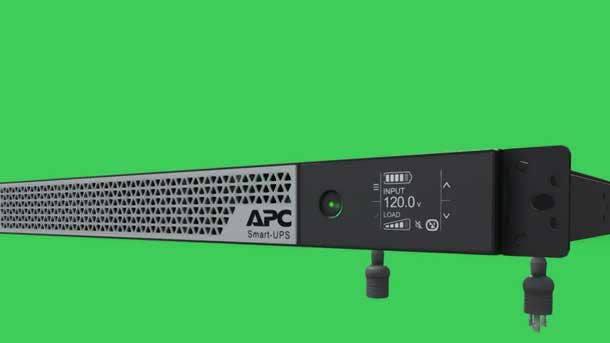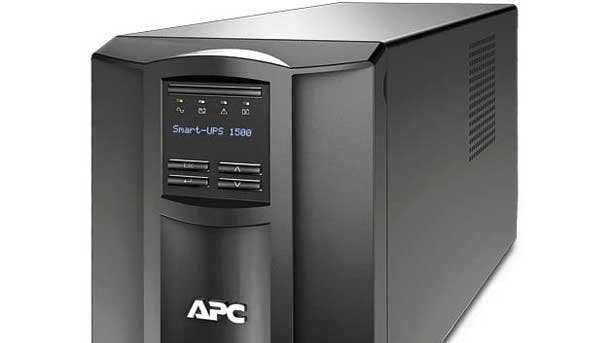Schneider Electric: 6 Ways UPS As A Service Boosts Channel Sales
‘We’re letting MSPs be a one-stop shop for their customers so they can lock down the whole sale and the whole life-cycle solution [with UPS as a Service],” says Schneider Electric’s Gail Fredrickson.

The Growing Channel Opportunities Around UPS As A Service
Schneider Electric partners can drive UPS margins and new power services sales through the company’s UPS as-a-Service offering while at the same time helping customers better manage their IT budgets and critical power needs.
Channel partners are selling Schneider Electric’s UPS as a Service to provide advanced monitoring tools and complete product life-cycle power protection to a wide variety of customers. Gail Fredrickson, director of channel marketing and strategy execution at Schneider Electric, and Larry Hann, director of channel digital services at Schneider Electric, spoke to CRN during XChange+ 2021 this week about why channel partners need to get on board the UPS-as-a-Service train.
“We’re letting MSPs be a one-stop shop for their customers so they can lock down the whole sale and the whole life-cycle solution,” said Fredrickson. “We don’t want MSPs to leave any more on the table around their customers’ power needs. … UPS as a Service gives them more tools and more visibility into their customers that will help them create more services opportunities.”
Here are six ways Schneider Electric’s channel partners can increase power management sales, services and stickiness with customers today.

Greater Insight And Services For ‘Dirty Power,’ Failures
Many customers buy a UPS, install it, and then forget about it. However, with Schneider Electric’s UPS as a Service, MSPs can give their customers significant visibility into their UPSes in real time, which helps in a variety of use cases.
One example is MSPs giving customers visibility into “dirty power,” meaning when the voltage is going up and down.
“Customers don’t have that visibility into that dirty power. All they know is the battery eventually failed and they have to do something about it. But they’re not looking at what’s causing that battery failure, which we could provide visibility into to actually get ahead of that downtime or even do things to extend the life of that battery. So you have more availability,” said Hann. “The other thing is, maybe you can stretch the life of that so it actually gives you more budget to go focus on other things go drive your business.”
Schneider Electric is giving partners visibility by monitoring and managing power in real time with UPS as a Service.
“The UPS is the filter to ensure that your very expensive networking gear that you paid millions of dollars for doesn’t get damaged,” said Fredrickson. “We’re the security blanket for everyone. For example, you spent $3 million on Cisco—well, spend $100,000 on power. It’s not a lot. Just don’t forget about it to ensure that you’ve protected that network.”

New 20 Percent Rebates Via Edge Software And Digital Services Partner Program
This year, Schneider Electric launched its Edge Software and Digital Services Program, a complete suite of rebates, benefits and support tools to enable channel partners to create a managed power services practice.
The new partner program offers solution providers rebate points across the UPS-as-a-Service sales and product life cycle to boost partner margins.
“We want to give then a 20 percent rebate across three different points. So when they first sell the UPS and they attach a managed service contract to it—so whether it’s our dispatch service or something they’re providing—they’ll get 20 percent back on that contract,” said Fredrickson. “Then when they connect it—because it’s one thing to sell the contract, it’s another to activate it—so when they activate the contract, that’s another step in the rebate cycle. At the end when they renew it again, that’s another [rebate] point.”
Fredrickson said Schneider Electric is incentivizing channel partners’ sales teams to make sure they’re following through on their offers—from the point of sale all the way through to renewal. “That’s what earns them those extra incentives along the way,” she said.

UPS As S Service Helps Save Downtime
Schneider Electric’s Fredrickson said 82 percent of customers have downtime.
“A lot of the time it’s caused by the power infrastructure and the power grid. So if you have what happened in Texas and in California happen … the key is to make sure that you have a graceful shutdown. That you just don’t lose everything. That’s where UPSes come in and that’s what people forget about—it’s those 15 minutes or 20 minutes where you have time to get your act together when you’re facing a long-term outage,” said Fredrickson. “You can make sure that you save everything and make sure your machines don’t get damaged. … We want to make sure that we’re driving that resiliency at the edge and that they feel very comfortable that if they have a power emergency their UPS is going to be ready to go.”
As more IT is being deployed outside the data center and into edge computing environments, it’s going to be even more critical for channel partners to manage UPSes.
“It’s going to be less and less acceptable for customers just to have the UPS—it’s got to be managed because that stuff has to be up and running,” said Hann. “Customers are going to have availability needs at the edge, which means that they’re going to need to manage that, which means the UPS needs to get the same level of availability in the data center out on these edge sites.”
Hann said customers can’t do this on their own. “The MSP is going to play a bigger and bigger role in providing that edge capability to their customers,” he said.

Capitalize On Customers Shifting Toward Opex IT Models
More customers are looking to save capital by moving toward as a service for their IT power infrastructure environment, said Hann. Schneider Electric is enabling partners to shift their customers into an opex model through distributors so solution providers “don’t have to outlay the capital,” he said.
“So the relationship is directly between the financing part of the distributor and the end user. So when you start talking about replacing UPSes—especially if a lot of them are in a distributed environment— now you can actually do it cost-effectively because it’s just a monthly payment,” said Hann.
Channel partners who provide UPS as a Service can still go forward providing and managing the latest and greatest technologies, but in a more cost-effective way.
“There are some customers that are able to just throw down a card, maybe they have a credit limit per month for a couple thousand dollars, and [UPS as a Service] makes it very easy for them to now actually move forward. It gives flexibility to those customers and partners to be able to do that without having to wait,” said Hann.

Bridge The Technology Gap In Disparate Install Bases
UPS as a Service helps partners provide new services and options for customers who have disparate install bases.
“If you look at the age of devices they have, they can have stuff that’s brand new or seven or eight years old. So they might need to do something quickly [where] the UPS as a Service enables them to bridge that gap,” said Hann. “So maybe they do a full refresh with everything, which they can quickly put in place.”
UPS-as-a-Service deals can be one-, three- or five-year agreements that fit into a customer’s overall budget cycle.
“Partners are already providing managed services to those customers maybe for other stuff like networking or storage or cybersecurity—whatever it might be—they’ve already established those relationships. So it’s easy for them to snap that consumption model into what they’re already providing to their customers,” said Hann.

New Opportunities In The New Remote, Hybrid Workforce With Monitoring And Dispatch Services
The new remote workforce stemming from the COVID-19 pandemic means not many people are on-site anymore, which opens the door for solution providers. Thanks to Schneider Electric’s Monitoring and Dispatch Services, channel partners who are not fully MSP experts yet will still be able to provide UPS as a Service.
“So even if you’re a partner that’s not a true MSP and you’re still in the hardware buy-resale phase and you work well with distributors, this allows you to say, ‘OK, we can still sell this,’” said Fredrickson. “What happens is, you’re selling through Schneider Electric as the MSP. We will manage and monitor, and then we’ll also roll the trucks—we’ll dispatch and we’ll do it all for them in one bundled service, and that comes through as UPS as a Service.”
Schneider Electric’s Monitoring and Dispatch Services provides value to partners because they don’t have to worry about monitoring and servicing on their own if they don’t have that capability. “And it also gives peace of mind to the customer because they’re working directly with the vendor—not another third-party provider—to make sure that their equipment is up to date and being closely watched,” said Fredrickson. “The goal is to make sure that our portfolio is for everyone. Anybody can do this no matter what.”